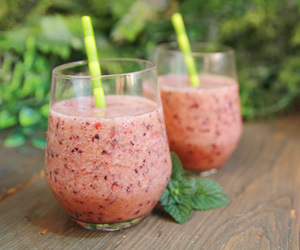Healthy Holiday Eating and Nutrition Tips
Celebrate the holiday season feeling your best. Keep your energy level high throughout the season with these simple tips for healthy holiday eating.
Juicing has become all the rage in recent years—but it doesn’t mean you should necessarily skip out on the smoothies or raw fruits and veggies you love. All are healthy options, but each poses pros and cons—here’s a few you should know.

Juicing extracts the water and nutrients from your produce—and leaves the fiber behind.
Pros
High nutrient content.Juicing requires much more produce than smoothies, which increases the nutritional content of the drink.
Easy digestion. Without the fiber smoothies or raw fruits and veggies have, juices give your digestive system a break, and allow your body to quickly absorb the vitamin and mineral content.
Cons
High sugar content. Since the insoluble fiber has been removed, the sugar content per volume increases—which can cause a significant insulin spike.
Short shelf-life. Light and air break down the nutrients; it’s best to drink up within 15 minutes of juicing.
The classic way to get your fruits and veggies—blending uses the entire the fruit or vegetable, often skin and all.
Pros
Satisfaction and creativity. Unlike juices, smoothies will leave you fuller, longer. Also, you can get creative with smoothies; add chia seeds, Greek yogurt or almond butter for a healthy addition.
High in fiber. A con in some cases, the high fiber content in smoothies can also be beneficial by keeping your digestive system in check and lowering your risk of diabetes and heart disease.
Cons
“Hidden” calories. Ingredients like almonds, Greek yogurt and avocado can quickly increase the calories in your smoothie. This doesn’t mean you shouldn’t add ‘em! Use in moderation.
Drink-up quick. Just like with juices, smoothies lose their nutrient content quickly—and it can be harder to gulp down a smoothie within 15 minutes.
Create a healthful snack, meal or garnish by mincing or finely chopping your vegetables into a slaw form.
Pros
Feels like a meal. These minced or finely chopped vegetables serve as a great side dish, garnish or as a topping for salads and sandwiches. Add organic extra-virgin olive oil for the added benefit of healthy fats.
Longer shelf-life. Slaw will last longer in the fridge than juices or smoothies; keep for 24-48 hours once prepared.
Cons
Digestive issues. For some, especially people who suffer from celiac disease and other conditions, the intact fiber can make digestion more difficult.
Prep time. Slaw can take a bit more time than juicing or smoothies—especially if you’ve opted to chop by hand.
Subscribe and get news, articles & offers sent right to your inbox each month.
"*" indicates required fields
By subscribing you are agreeing to the Terms and Conditions and Privacy Policy.